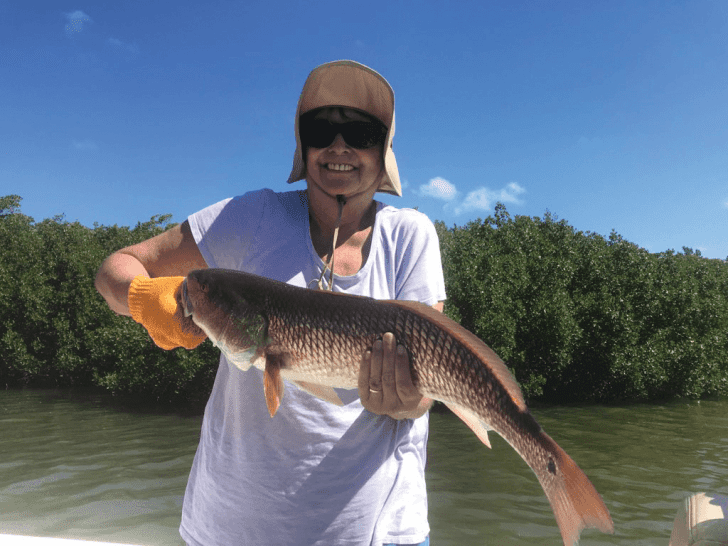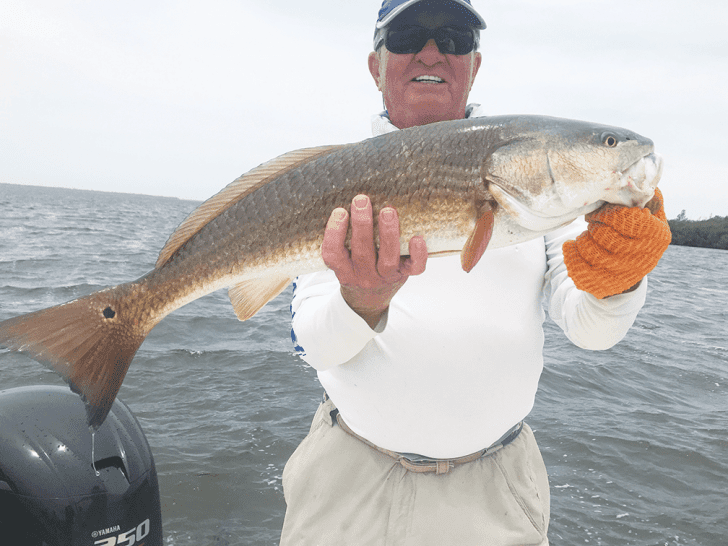by Capt. Terry Fisher
August fishing proved to be rather tough due to the red tide and algae blooms, which much of the world is aware of. This was applicable to inshore and offshore fishing alike. Most of my ‘Gulf Coast’ experience is attributed to inshore and there I will focus attention. The toughest challenges for August were not only locating fish, but also finding locations not affected by red tide. Any given day would present challenges depending on tidal movements (incoming or outgoing) and wind direction. Incoming tides would push dead fish inshore while outgoing tides assisted in relieving Pine Island Sound and the passes of dead fish and stench. Incoming tides supported by south and west winds generated most of the problem, while easterly winds would assist in keeping dead fish out to sea. Nonetheless, with perseverance and extra efforts, most of my charters enjoyed catching fish by circumventing affected areas.
September fishing should be easier and much better with the summer rains subsiding. This alone will provide relief from the intrusion of too much fresh water being released from Lake Okeechobee. Due to Earth’s axis, summer tide levels will be at their peaks, allowing inshore guides and fishermen to take advantage of many ‘back’ country venues not accessible during other times of the year. These same estuaries were the least affected by the red tide and algae blooms of August allowing the harvest of fish to be decent all summer long, but should be even better this month.
Depending on the type of charter request, my target species will be redfish, as they are beginning their yearly ‘inshore’ migration to eat and spawn. If history repeats itself, they will be here in big numbers and big sizes. My advice is to ignore any negative press and all naysayers as September may be one’s best opportunity for a ‘fish of a lifetime’. My strategies for finding and targeting these fish are to take advantage of the high September tides and fish the ‘back’ country venues around the mangrove islands and oyster bars. I suggest fishing Matlacha Pass (both north and south) and areas such as Two Pines (north) and Punta Rassa (south). Look for them as far north as Bull Bay, Turtle Bay, and the bar protecting Cape Haze in Charlotte Harbor. These ‘brutes’ are on the move and will be around these areas.
Many guides prefer to fish on a low tide in effort to see them ‘tailing’. My preference is to fish for them on a high, incoming tide around mangroves, oyster bars and sand bars. I am a proponent of light tackle that will provide a challenge when ‘fighting’ and ‘landing’ these game fish. When fishing for spawning redfish however, I recommend using 4000 series reels loaded with 10-15lb line (drags set tight) mounted on ‘Medium’ to ‘Medium Heavy’ (10-20lb) line test rods, as these fish are big and powerful. The baits are your choice on 1/0 to 3/0 circle or ‘J’ hooks. Cut pinfish, ladyfish, or white baits all work, but I prefer big shrimps on the bottom or under a popping cork against the mangroves. The advantage to adopting my strategy is that one is just as likely to catch a nice seatrout or a big snook, as a bonus.
I recommend the same equipment for big snook, but the equipment for most other inshore species may be down-sized to 2500-3000 series reels with 10lb. test line, mounted on 8/17lb. line test rods. The length of rod will determine the distance of the cast. The shorter the rod, the shorter the cast! Seatrout, pompano and mangrove snapper are around and fun to catch on light tackle. I basically use small shrimp or pilchards for these fish. In my opinion, shrimp is the most effective bait for these species. Place one on small circle or ‘J’ hook under a popping cork, with or without a weight. Fish the grass flats of Pine Island Sound and Matlacha Pass in about 4-6 foot of water over turtle grass for best results for seatrout, pompano and mackerel. Mangrove snappers will be found around most any shallow mangrove roots.
September is a great time to fish as the pressures on fishing locations are less than that of other months. Many families are preparing to send their children ‘back to school’ leaving the waters to full-time residents. It is mostly yours for the taking.


